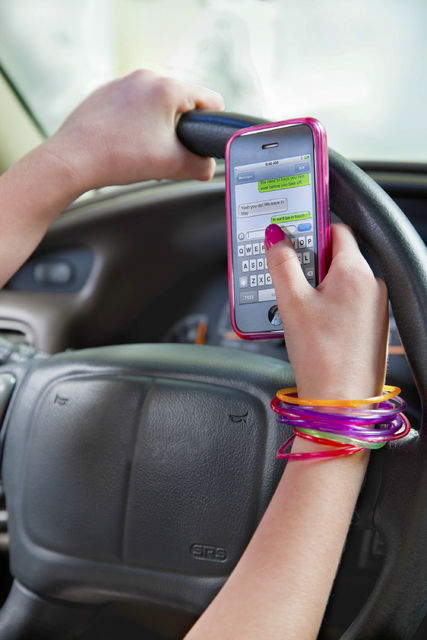KEKAHA — Tony Ricci, Garden Island Racing Association president, understands the dangers of distracted driving. “I know from past experience trying to look for a phone number one time and getting into a fender bender,” he said. And when it
KEKAHA — Tony Ricci, Garden Island Racing Association president, understands the dangers of distracted driving.
“I know from past experience trying to look for a phone number one time and getting into a fender bender,” he said.
And when it comes to texting and driving, Ricci said it’s “one of the most dangerous things out on the road today.”
“Texting is what we all do. It really does take a lot of attention away from you,” he said. “I think it’s a huge problem as our kids are getting to driving age and just learning how to drive — they’re growing up texting. Texting is their form of communication.”
The dangers are why Hawaii state law bans the use of hand-held mobile electronic devices while operating a vehicle.
And Hawaii’s fines are meant to deter drivers from grabbing their cells, as the Aloha State ranks above the national average fine of $112.
Well above.
Fines start at $250 and run to $300 for breaking the law in school and construction zones. It’s nowhere near the $10,000 fine for phoning and driving Alaska has in place, but it’s still higher than most.
Ford Fuchigami, Hawaii Department of Transportation director, said texting while driving is among the main distractions for drivers.
“While anything that takes your eyes off of the road, hands off of the wheel, or mind off of the task of driving is a hazard, there is a heightened concern about the risks of texting while driving because it combines all three types of distraction — visual, manual and cognitive,” he said in a statement.
Drivers under the age of 18 are banned from talking on cellphones in Hawaii. That includes hands-free devices.
As of June, Kauai police have issued 539 tickets to violators operating hand-held mobile electronic devices while driving, according to KPD reports.
“We do not have stats on the number of crashes caused by texting and driving here on Kauai,” KPD spokeswoman Sarah Blane wrote in an email. “However, if an officer believes that may have been a factor cause of a collision, the driver will be cited.”
During federal fiscal year 2014, the county police departments statewide issued more than 11,000 distracted driving citations.
“All forms of distracted driving are dangerous, but studies continue to show that texting/messaging while driving is the most dangerous, and significantly increases the likelihood of a crash,” Assistant Chief of the Patrol Services Bureau Roy Asher wrote in an email.
Still, some are caught off guard when getting a $300 ticket for a first-time offense of holding a phone in a car.
One 38-year-old Kalaheo woman, who didn’t want to provide her name as she was planning on not paying her fine, said she was amazed when she received a $375 ticket for changing the Pandora radio station on her phone while she waited in traffic after leaving Salt Pond one Sunday afternoon. Her license had been expired, as well. The cost still shocked her.
“Especially here on-island, I feel that’s astronomical,” she said. While she’s now very aware of the risks of using a phone in a car, a cheaper ticket would have taught her the same, she said. “That’s why I’ve avoided it. It’s too much money.”
In 2013, there were 3,154 people killed and 424,000 people injured nationwide in motor vehicle crashes involving distracted drivers, according to the National Highway Traffic Safety Administration.
Drivers in their 20s make up 27 percent of the distracted drivers in fatal crashes, and teens are the most at risk, as drivers under the age of 20 text more than any other age group.
“For them, it’s automatic to start texting without even thinking about it,” Ricci said. “Now they’re behind a wheel and doing it, and it becomes so intuitive that they’re not even thinking of what they’re doing. They really have to emphasize that phones have to be out of your hands.”
National Highway Traffic Safety Administration added that drivers who use hand-held devices while driving are four times more likely to get into crashes serious enough to injure themselves or others.
“Our hope is that drivers will commit to distracted-free driving for their own safety and the safety of their passengers and fellow motorists, but officers will cite drivers who choose not to obey the law,” Asher said.
As part of a 2016 initiative to educate high school students, Ricci and other members of GIRA will coordinate with the Department of Education and speak with students islandwide about safe driving measures.
“We need to come to them. We gotta be there for them,” he said. “We really want to go to the high schools and do general assemblies and talk to the kids about safety.”
In order to avoid crashes and fines, Fuchigami gave drivers a bit of advice.
“It’s best to turn off your phone or mobile electronic device and put it in the trunk, glove compartment or back seat where you won’t be tempted to look at it or use it,” he said.


